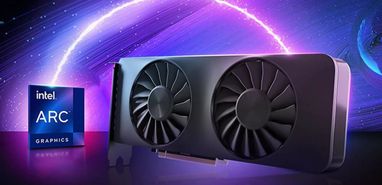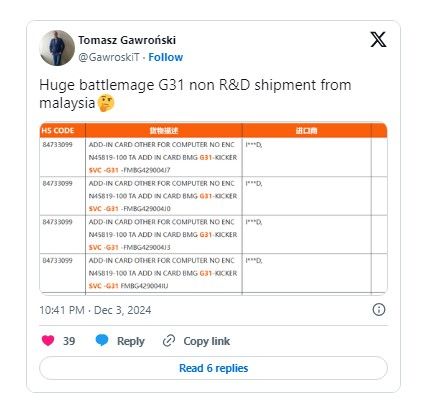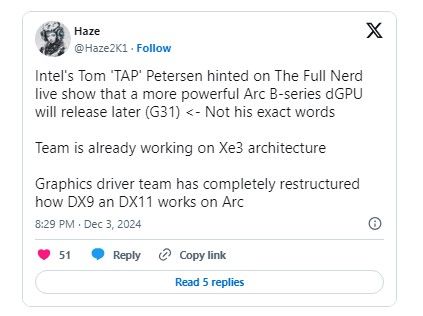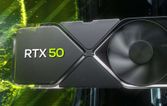
Intel continues to challenge the discrete GPU market, dispelling rumors of retreat with fresh evidence of its advanced Arc Celestial “Xe3” and high-performance Battlemage “G31” GPUs emerging online.
Intel’s Commitment to Xe3 & Xe4 GPU Development
In a strong statement of intent, Intel recently showcased its Battlemage B-Series lineup, including the Arc B580 and Arc B570 GPUs. Positioned within the sub-$250 price range, these cards aim to capture the mainstream gaming audience, competing head-on with offerings from AMD and NVIDIA.
Intel’s Battlemage series is designed to appeal to the gaming community—a strategy AMD is also pursuing with its upcoming RDNA 4 “Radeon RX 8000” series. However, Intel’s roadmap may include unexpected surprises.
Recent shipping manifests from NBD.ltd revealed the Intel BMG-G31 SoC, suggesting the potential release of a more powerful B-Series GPU in the near future. The Arc B580 and B570 GPUs are built on BMG-G21 SoCs, but the G31 variant, with an increased number of Xe2 cores, could power models like the Arc B770. Intel’s Tom Petersen hinted at a high-performance B-Series GPU, further fueling speculation.

Progress on Intel’s Arc Celestial “Xe3” GPUs
Intel’s next-generation Celestial GPUs, codenamed “Panther Falls,” have also surfaced in shipping documentation. These listings, which include Qualification Samples (QS) and fully assembled boards, indicate that Intel is actively advancing its discrete GPU lineup.
The Celestial GPUs are expected to bring significant improvements. For example, a spotted model featuring 128 EUs (or 16 Xe3 cores) could serve as an entry-level discrete GPU option. Panther Lake CPUs will integrate Xe3 GPUs with up to 12 cores, highlighting Intel’s efforts to cater to a broad range of gaming and professional needs.
Intel has confirmed the completion of Celestial’s development, with the company’s engineering team now focused on the Druid “Xe4” lineup. This progression demonstrates Intel’s commitment to building a robust and competitive GPU portfolio.

What’s Next for Intel Discrete GPUs?
The continuation of Arc Celestial and the emergence of next-gen Battlemage GPUs signal Intel’s intent to establish a lasting foothold in the discrete GPU market. At CES 2025, Intel is expected to provide more updates on its GPU strategy. Meanwhile, GPUs like the Arc B580 and B570 are poised to solidify Intel’s position in the mainstream segment, challenging both AMD and NVIDIA.
Intel ARC Gaming GPU Roadmap
| GPU Family | Intel Xe-HPG | Intel Xe-HPG | Intel Xe2-HPG | Intel Xe3-HPG | Intel Xe Next | Intel Xe Next Next |
|---|---|---|---|---|---|---|
| GPU Products | Arc Alchemist GPUs | Arc Alchemist+ GPUs | Arc Battlemage GPUs | Arc Celestial GPUs | Arc Druid GPUs | Arc E*** GPUs |
| GPU Segment | Mainstream Gaming | Mainstream Gaming | Mainstream/High-End | Mainstream/High-End | Mainstream/High-End | Mainstream/High-End |
| GPU Gen | Gen 12 | Gen 12 | Gen 13? | Gen 14? | Gen 15? | Gen 16? |
| CPU iGPU | Xe-LPG (Meteor Lake) | Xe-LPG+ (Arrow Lake) | Xe2-LPG (Lunar Lake) | Xe3-LPG (Panther) | TBA | TBA |
| Process Node | TSMC 6nm | TSMC 6nm | TSMC 5nm | TSMC 3nm? | TBA | TBA |
| Specs/Design | 512 EUs/1 Tile/1 GPU | 512 EUs/1 Tile/1 GPU | 1024 EUs/1 Tile | TBA | TBA | TBA |
| Memory Subsystem | GDDR6 | GDDR6 | GDDR6 | TBA | TBA | TBA |
| Launch | 2022 | 2024 | 2024 | 2025? | 2026? | 2026+ |








By Radoslav Jokic
Updated on 9th March 2025